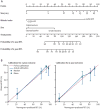Nomograms in oncology: more than meets the eye
- PMID: 25846097
- PMCID: PMC4465353
- DOI: 10.1016/S1470-2045(14)71116-7
Nomograms in oncology: more than meets the eye
Abstract
Nomograms are widely used as prognostic devices in oncology and medicine. With the ability to generate an individual probability of a clinical event by integrating diverse prognostic and determinant variables, nomograms meet our desire for biologically and clinically integrated models and fulfill our drive towards personalised medicine. Rapid computation through user-friendly digital interfaces, together with increased accuracy, and more easily understood prognoses compared with conventional staging, allow for seamless incorporation of nomogram-derived prognosis to aid clinical decision making. This has led to the appearance of many nomograms on the internet and in medical journals, and an increase in nomogram use by patients and physicians alike. However, the statistical foundations of nomogram construction, their precise interpretation, and evidence supporting their use are generally misunderstood. This issue is leading to an under-appreciation of the inherent uncertainties regarding nomogram use. We provide a systematic, practical approach to evaluating and comprehending nomogram-derived prognoses, with particular emphasis on clarifying common misconceptions and highlighting limitations.
Copyright © 2015 Elsevier Ltd. All rights reserved.
Conflict of interest statement
Figures


References
-
- Grimes DA. The nomogram epidemic: resurgence of a medical relic. Ann Intern Med. 2008 Aug 19;149(4):273–5. - PubMed
-
- Gospodarowicz M, Benedet L, Hutter RV, Fleming I, Henson DE, Sobin LH. History and international developments in cancer staging. Cancer Prev Control. 1998 Dec;2(6):262–8. - PubMed
-
- Cho CS, Gonen M, Shia J, Kattan MW, Klimstra DS, Jarnagin WR, et al. A novel prognostic nomogram is more accurate than conventional staging systems for predicting survival after resection of hepatocellular carcinoma. J Am Coll Surg. 2008 Feb;206(2):281–91. - PubMed
-
- Kattan MW. Nomograms are superior to staging and risk grouping systems for identifying high-risk patients: preoperative application in prostate cancer. Curr Opin Urol. 2003 Mar;13(2):111–6. - PubMed
-
- Wong SL, Kattan MW, McMasters KM, Coit DG. A nomogram that predicts the presence of sentinel node metastasis in melanoma with better discrimination than the American Joint Committee on Cancer staging system. Ann Surg Oncol. 2005 Apr;12(4):282–8. - PubMed
Publication types
MeSH terms
Grants and funding
LinkOut - more resources
Full Text Sources
Other Literature Sources
Medical

